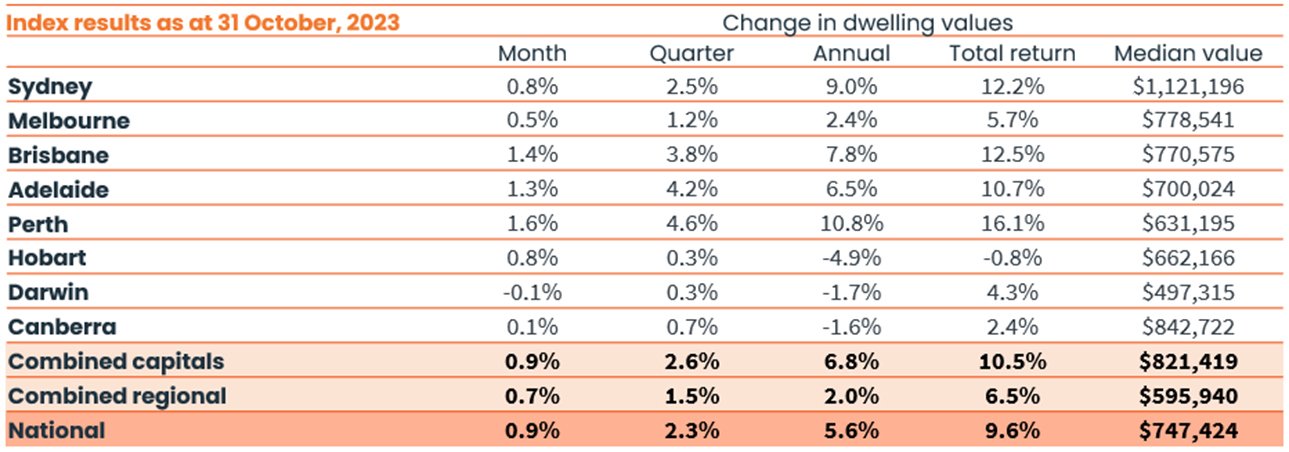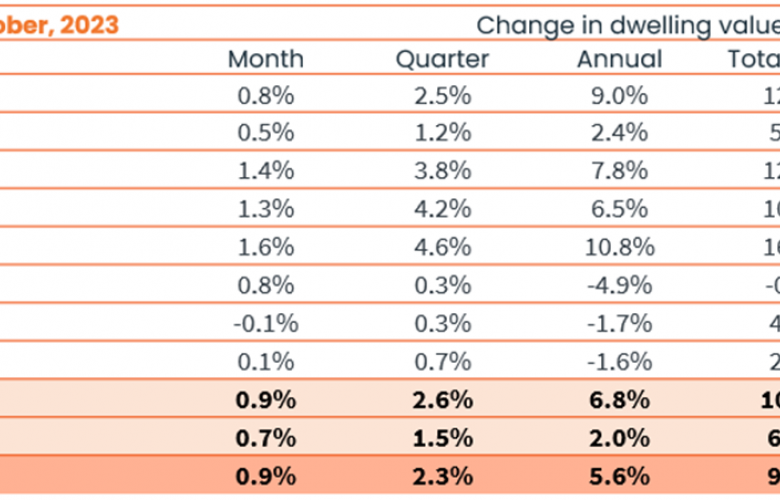CoreLogic Home Value Index up 0.9% through October but some downside risks emerging
Contact
CoreLogic Home Value Index up 0.9% through October but some downside risks emerging
CoreLogic’s national Home Value Index rose a further 0.9% in October, accelerating from a 0.7% rise in September (revised down from 0.8%).
CoreLogic’s national Home Value Index rose a further 0.9% in October, accelerating from a 0.7% rise in September (revised down from 0.8%). Since finding a trough in January, the national HVI has increased 7.6%, leaving the index only half a percent below the historic high recorded in April last year.
CoreLogic’s research director, Tim Lawless, noted a nominal recovery in the national index is likely to be just around the corner. “At this rate of growth, we will see the national HVI reach a new record high mid-way through November, recovering from the -7.5% drop in values recorded over the recent downturn between May 2022 and January 2023.”
Although housing values are consistently rising across most capital cities, there’s been a clear slowdown in the quarterly pace of growth trend. The three months ending June 2023 saw capital city home values rise by 3.7%. Since then the growth trend has drifted back to 2.6% over the three months to October.
“The slower rate of appreciation can probably be attributed to a combination of higher advertised stock levels alongside stretched affordability,” Mr Lawless said. “With an acceleration in the flow of new listings coming onto the market, it’s unlikely buyer demand will be able to keep pace as we move through spring amid high interest rates and low sentiment.”
Dwelling values rose across each of the capital cities except Darwin (-0.1%) through the month, with Perth (1.6%), Brisbane (1.4%) and Adelaide (1.3%) continuing to outperform the other capitals.
Three capitals have seen dwelling values rise by more than 10% over the first 10 months of the year, led by Sydney (10.9%), Perth (10.8%) and Brisbane (10.2%).
Brisbane housing values posted a nominal recovery in October, erasing the previous -8.9% drop in values to reach a new record high. Perth and Adelaide are also at new record highs after recovering from shallow downturns earlier this year. The remaining capital cities have some way to go, with Sydney values -2.2% below their January 2022 peak and Melbourne values -3.7% below the March 2022 peak. Hobart values are down the most from their recent high, remaining -11.6% below peak levels.
Regional markets continue to lag their capital city counterparts. At a broad level, the combined regional index was up 0.7% in October compared with a 0.9% rise across the combined capitals, and this trend of higher growth in the capitals was evident across every state.
“Despite the slower pace of growth, every rest of state region recorded a rise in home values over the month, except Regional Tasmania where values were flat,” Mr Lawless said. “Similar to the trend in the capitals, Regional Queensland, WA and SA are showing stronger conditions with each of these rest of state regions at record highs in October.”
Of the 307 SA3 regions analysed nationally, 41 (13.4%) recorded a drop in value over the past three months, with most located in Regional Victoria (11 SA3’s) and Regional NSW (6 SA3’s).
“Regional Victoria remains the softest of the rest of state regions, with housing values holding virtually flat (-0.2%) over the rolling quarter, holding -7.2% below the May 2022 peak. The soft conditions come amid rising stock levels, which are 27.2% higher than a year ago and 11.1% above the previous five-year average, and low demand, with estimated sales activity tracking -17% below the previous five-year average,” Mr Lawless said.







